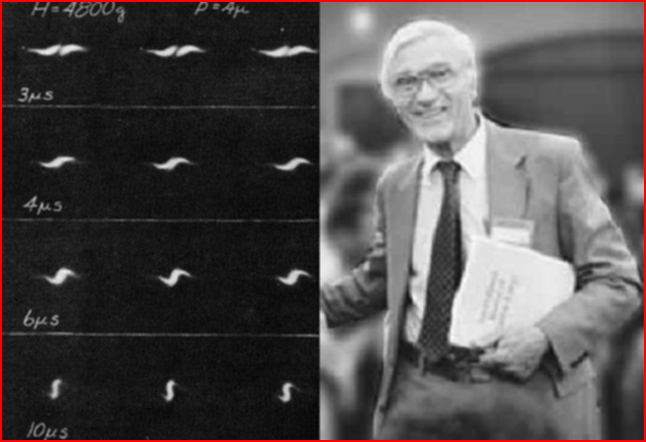
home •
about •
essential guide •
picture of the day •
thunderblogs •
news •
multimedia •
predictions •
products •
get involved •
contact
picture of the day archive subject index
Left: Two plasmoids in a magnetic field producing similarities to the shape of barred spiral galaxies.
Right: Winston H. Bostick makes the news headlines in 1956.
Jun 26, 2008
Bostick’s PlasmoidsOn December 12, 1956, the front page of the New York Times announced: "Physicist 'Creates' Universe in a Test Tube; Atom Gun Produces Galaxies and Gives Clues to Creation".
Just over 50 years ago, plasma physicist Winston H. Bostick made the kind of news headlines that many a scientist dreams. In his laboratory experiment Bostick created a simple "plasma gun" consisting of a 4-inch diameter glass jar around which he wound a wire carrying an electric current that created a small magnetic field. Most of the air was removed from the jar and two titanium wires were connected to a high-voltage, high-current electric power source.
On flicking the power switch, a 10,000 ampere electric current passed through the titanium wires, instantly vaporizing them and creating a puff of ionized gas (a plasma) travelling at 450,000 miles per hour. Bostick noted that the puffs of plasma formed distinctive shapes that resembled galaxies at various stages of aging and formation. Bostick called his laboratory produced plasma entities, "plasmoids".
Over the next thirty years, Bostick, a Professor of Physics at Stevens Institute of Technology in Hoboken, New Jersey, investigated plasmoids further and found that "not only the morphology [shape] but the controlling dynamic elements, electric and magnetic fields, are the same in the laboratory as in the galactic phenomena".
Bostick's theory describes galaxies as analogous to series-wound homopolar generators (a kind of motor) that convert gravitational energy of rotation into increasing magnetic energy that causes galaxies to expand away from each other. Furthermore, Bostick suggested that such a model could produce a concentration of current perpendicular to the galactic disk that would be a cosmic-sized "plasma focus" – a device that produces high energy, relativistic (near the speed of light) particle beams, or jets.
Winston H. Bostick was born in 1916, and died January 19, 1991, at age 74.
Further reading:
http://www.plasma-universe.com/index.php/Winston_H._Bostick
http://www.plasma-universe.com/index.php/Plasmoid
Contributed by Ian Tresman
http://www.plasma-universe.com
__________________________________________________________________________
Please visit our new "Thunderblog" page
Through the initiative of managing editor Dave Smith, we’ve begun the launch of a new
page called Thunderblog. Timely presentations of fact and opinion, with emphasis on
new discoveries and the explanatory power of the Electric Universe."The Electric Sky and The Electric Universe available now!

|
|

|
EXECUTIVE EDITORS:
David Talbott, Wallace Thornhill
MANAGING EDITORS:
Steve Smith, Mel Acheson
CONTRIBUTING EDITORS: Michael Armstrong, Dwardu Cardona,
Ev Cochrane,
C.J. Ransom, Don Scott, Rens van der Sluijs, Ian Tresman
WEBMASTER: Brian Talbott
Copyright 2008: thunderbolts.info
![]()
home •
thunderblogs •
forum •
picture of the day •
resources •
team •
updates •
contact us

